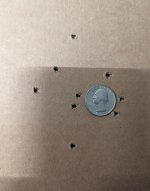Spent about 45 minutes last night looking through the scope at a mirror. (Thanks @rsterne)
The mirror trick proved that I had the "A" scenario shown in this graphic (graphic shared by Bob Sterne but I think original source was
@Scotchmo)
Lots of guns ago I was in the habit of mounting the scopes using a plumb line to find vertical. I moved away from that when I found that true vertical/horizontal feels cattywampus when I spend any time looking through the scope (shooting)
So for years I've mounted scopes to what "feels" vertical and horizontal to me. Apparently I'm a little off kilter, lol.
At this point, and based on 15 months and lots of field target success with a scope mounted with what seems to be some serious scope cant, I'm of the opinion that scope cant at normal < 100yard airgun ranges is a non-issue, or at least can be accounted for with good dope data. Or rather a non-issue in the critter smacking and EBR targets and field target realm (might be more of a problem in the real benchrest world).
I didn't start this conversation looking for a solution or a fix, but in the interest of learning, I decided to rotate the scope in the rings to make the vertical stadia intersect the bore. In order to do that, the rifle must be canted, like in C. I'm not sure I love how it feels for the scope to seem crooked to me now,, or for the gun to need to be canted but I'm going to do some long range shooting and see if the gradual right tracking of impact points as distance increases thing is minimized by this. If I can't handle feeling like I'm falling over, I'll simply rotate the scope back to how I like it and account for the right drift at the longer ranges like I've been doing up til now.
Per Miles, some right-tracking (spin drift) will still exist. (Thanks Miles)
Following a recent question and discussion on spin drift for slugs, I was asked if I could post this old thread from a UK forum. I wrote it for sub 12FPE guns using pellets, so the speeds are low and slugs are not considered. The general effects are the same at high speeds and for slugs. The...

community.hardairmagazine.com
(I know links to the competitor forum is frowned upon, but hopefully Michael will allow the link to remain intact, for the purposes of this discussion.)

